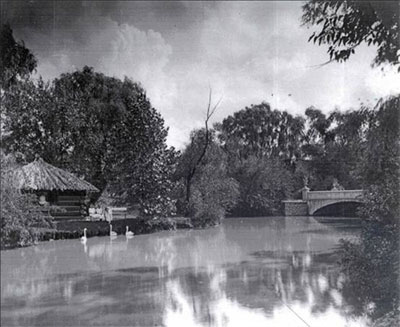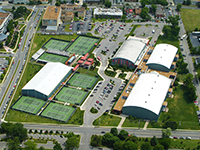Centennial Park is one of Nashville's premier parks. Located on West End and 25th Avenue North, the 132-acre features: the iconic Parthenon, a one-mile walking trail, Lake Watauga, the Centennial Art Center, historical monuments, an arts activity center, a beautiful sunken garden, a band shell, an events shelter, sand volleyball courts, dog park, and an exercise trail. Thousands of people visit the park each year to visit the museum, see exhibits, attend festivals, and just enjoy the beauty of the park.
Centennial Park is also home to the Centennial Sportsplex.
Metro Parks and The Nature Conservancy have partnered on a new initiative called "If Trees Could Sing," a set of 18 Web videos with Nashville music artists talking (and sometimes singing) about trees, their benefits and how to take care of them. Custom tree signs were installed in Centennial Park that have QR codes and web addresses so visitors can use their smartphones to view videos of Nashville talent telling tree stories. The initiative will provide park visitors a reason to approach the trees and offer a creative way to engage with them.
Read more about the If Trees Could Sing project

Park History
--from the book, The Parks of Nashville: A History of the Board of Parks and Recreation by Leland R. Johnson
This park was the site of the 1897 Tennessee Centennial Exposition. It previously had been a farm purchased in 1783 by John Cockrill, the brother-in-law to James Robertson, then became the state fairgrounds after the Civil War and from 1884 to 1895 became a racetrack known as West Side Park. Construction of the buildings for the 1897 Centennial began in 1895 with the laying of the cornerstone for the Parthenon replica on October 8, and a large number of elaborate structures were built to serve the 1.8 million visitors to the Exposition from the President down. When the Exposition closed on October 30, 1897, its leadership called for preservation of the Parthenon replica and the Centennial grounds as a public park, initiating the city park movement in Nashville.
As the result of a litigation settlement with city government, Percy Warner and the Nashville Railway and Light Company purchased the first 72 acres of Centennial Park for $125,000 and gave it to the Park Board on December 22, 1902. The Park Board built a swimming pool, stocked Lake Watauga with fish, planted flower gardens and shrubs, built drives and walkways, and opened the park to the public in 1903, scheduling Gilbert and Sullivan operettas for cultural recreation purposes and also providing art exhibits in the Parthenon.
During 1903, the monuments paying tribute to James Robertson and to the leaders of the 1897 Centennial Exposition were erected in the park, becoming the first of many monuments and memorials placed throughout the park. In 1903 the Park Board leased the Elliston Tract across 25th Avenue from the park as the site of ball diamonds, tennis courts, and a football field; it purchased the tract in 1911 and named it the Centennial Athletic Field. Land exchanges with the railroad north of the park and purchases of residential properties around the periphery of the park gradually expanded the park area to its present size.
The first community center in the park was constructed in 1916, with a trolley car located in the playground at its side. The steam locomotive was placed in the park in 1953 and the fighter plane in 1961. The Sunken Gardens in 1897 was a pond called Lily Lake and from 1922 to 1949 was a Japanese Water Garden displaying aquatic plants. The bridge between the Sunken Gardens and Lake Watauga was constructed in 1906 and is the first reinforced concrete bridge built in Tennessee. The Centennial Park swimming pool, built in 1932, was reconstructed as the Centennial Art Center in 1972, with the site of the pool becoming a sculpture garden. Ice Centennial was built in 1978. The Parthenon replica of 1897 was reconstructed of concrete from 1921 to 1931 and received a minor renovation in 1962. The Centennial Croquet Club was constructed in 1963, although croquet courts had occupied the site many years before. The Confederate powder wheels were moved into the park from Sycamore Mills during the 1897 Centennial and are probably the most prominent artifact of the Exposition in the park, though many others are scattered functionally and unobtrusively throughout the park.
Centennial Park Resources
2500 West End Avenue
Nashville, TN 37203
Park Hours: Dawn to 11 p.m. daily
The Conservancy
The Conservancy is a private, not-for-profit organization, serving the community through stewardship and promotion of The Parthenon and Centennial Park.

